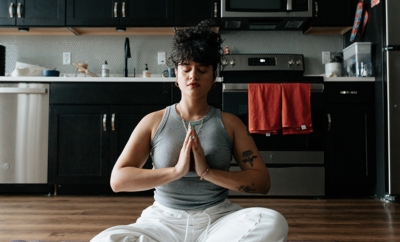Need Help Regulating Emotions? Here Are 7 Ways Yoga Can Support

Yoga is an amalgam of several different practices, which include physical postures (Asanas), breathing exercises (Pranayama), and meditation (Dhyana).
Yoga is unique among traditional Eastern healing arts in that it includes both physical movement and contemplative procedures. It also involves focusing or directing one’s attention. One benefit of this all-encompassing practice is that yoga can aid in emotion regulation.
What is Emotion Regulation?
The American Psychological Association defines emotion regulation as “the ability of an individual to modulate an emotion or set of emotions”.
Angela Wilson, LMHC, RYT-500, Kripalu faculty member, explains emotion regulation as “the ability to manage one’s thoughts, feelings, and behaviors in such a way as to maintain adherence to one’s overall life goals and intentions”.
7 Ways Yoga Can Help Regulate Emotions:
1. Release Tension
Yoga is a great practice to relieve stress and tension through movement or stillness. The practice of yoga can bring up intense emotions on the mat and even bring light to your stress points, regardless of what your practice entails.
This transformative practice can give you valuable knowledge about how you hold tension in your body when you are in motion or settled into stillness.
The practice of yoga involves being in the present moment. We experience firsthand where tension may show up physically, mentally, or emotionally on the mat.
Once you become mindful of what surfaces for you on the mat, you can begin to notice and tend where you may experience tension outside of your yoga practice.
Try this YA Class restorative practice restorative practice to help you move inward and deeply relax. Make note of what surfaces for you!
2. Find Your Breath
Breathwork (Pranayama) teaches us to focus on something other than emotions. By focusing on the breath and breath patterns, we not only shift our focus, but become more mindful and present in the moment.
The breath is a powerful tool that allows going within self while slowing the nervous system, creating a calming effect in the body to aid in emotion regulation.
Check out this excellent YA Class on Breath Awareness that’s beneficial for anyone brand new to breathing techniques or seasoned Pranayama practitioners.
3. Practice Acceptance
Noticing emotions that come up in your yoga practice and acknowledging them without judgment can help you come to accept them. In her many works, Tara Brach introduces this concept as Radical Acceptance.
In practicing acceptance of what is, we come to understand that we may not necessarily need to act out the feelings and thoughts we experience (react); we only need to observe them and let go of attaching any meaning or story to them (respond).
4. Develop Perspective
Yoga teaches us to take the good with the bad and practice acceptance of what is. When we develop awareness around how our perspective is shaped by emotions, it is possible to tend to the underlying issues and develop a different perspective.
Emotion regulation is “the ability of an individual to modulate an emotion or set of emotions.”
It’s important to note emotions are part of the human experience. How we tend to ourselves while experiencing these emotions is key to understanding and managing them.
Shift Your Perspective On Negative Emotions – Why They May Actually Be Good For You!
5. Move Your Body!
Yoga teaches us that by engaging our body through movement (Asana), we regulate emotions by increasing serotonin levels, thus creating a sense of peace within ourselves.
In one study, physical and mental health benefits of yoga or physical exercise were compared. They found yoga may be as effective or better than physical exercise!
Choosing to engage in movement routinely, whether yoga or other forms of physical activities, has proven to have a plethora of benefits. This can be especially important in this digital age where many are in sedentary jobs or in remote work.
If You Have a Desk Job, Your Body Will Thank You For These 5 Desk Yoga Poses
6. Learn Mindful Communication
Emotions can affect how we communicate with others. If we aren’t mindful of emotions we experience, it can lead to using words or nonverbal communication unconsciously or impulsively.
Mindful communication allows your words and actions to be clear. It requires you to tune in, using the wise mind, rather than sharing only from considering facts and logic (reasonable mind) or from pure emotion (emotion mind).
The late Psychologist, Dr. Marsha Linehan, created Dialectical Behavior Therapy (DBT), one of the widely used treatment models for emotion regulation clinicians.
7. Practice Loving-Kindness
Through our yoga practice, we learn to treat ourselves with loving-kindness. The Loving-Kindness meditation encourages sending love to self, others, and the Universe.
One review notes “loving-kindness, also known as metta (in Pali), is derived from Buddhism and refers to a mental state of unselfish and unconditional kindness to all beings.”
Yoga Helps Us Connect and Regulate Emotions
In conclusion, yoga helps regulate emotions in various ways. Yoga is a synergistic practice of breath, mind and body.
When combined with the ethical teachings of the yamas and niyamas as taught by Patanjali’s eight-limbed path, yoga is more than practicing physical postures, but a whole-body experience.
Yoga brings us back to our center wholly to work through difficult emotions rather than let them consume us.
Did any of these ways resonate with you? Or better yet, how does yoga help you regulate emotions? Please share with us in the comments below – we love hearing from you!

























Comments